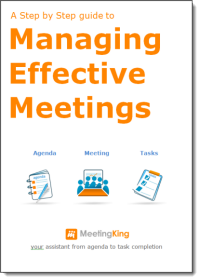This is a guest post by Alan Cairns. Alan writes on a number of subjects including virtual receptionist services.
Meetings are a bug bear for many business professionals. Many say that meetings take up all their time and they can’t get any “real” work done because of it.
Meetings are an essential part of business; to reach agreements, share ideas, set strategies and most importantly to communicate in an open, face-to-face situation. It’s understandable that many professionals tire of meetings, because so many of them are badly organised, unproductive and ultimately pointless. Meetings can go wrong for a variety of reasons, but this article is aimed at helping you plan and executive a successful meeting.
Agenda
An agenda is one of the most important parts of any meeting. It gives attendees an idea about the content of the meeting, what they will be expected to understand or contribute, and gives them an opportunity to properly prepare for it.

Circulate the meeting agenda as soon as possible, ideally with the initial meeting invite but otherwise at least a day before the meeting is due to take place. It’s hard for attendees to know if they want to attend the meeting if they don’t fully understand what it is about and its importance.
When planning a meeting agenda, consider where conversations are likely to develop, and leave time for this. If you are making a presentation then plan how long it should take and try your best to stick to it. If a meeting is scheduled for an hour then be prepared for your attendees to leave to make their next appointment after the allotted time has passed.
Attendees
When inviting people to your meeting, ensure you only invite the ones who need to be there. If you’re just inviting them to keep them “in the loop” then consider forwarding the meeting notes after it has happened. We’ve all been sat in a meeting at one point or another and wondered “Why am I here?”
If you’re not exactly sure who needs to be at your meeting, and would like to extend the offer to other people who might be interested then make sure that you inform them that their attendance is not necessarily required. Equally, if a particular person is essential to your meeting being productive then let them know that their attendance is essential.
Scheduling
Scheduling a meeting can be tricky, and if key attendees have busy schedules you might find that your meeting gets shunted around to fit with their diary. There’s not much you can do about this, but try to plan meetings at times when these people are unlikely to have other engagements. You should also try to book a meeting room when there is not another meeting running immediately beforehand and afterwards. This may be unavoidable but it can take the stress out of a meeting if you allow set-up and pack down time. Show respect for other people’s meeting by ensuring you are out of the room by the time their meeting is due to start.
Running Late
If on the morning of your meeting you start to receive emails, phone calls, text messages or other communications warning you that a certain attendee might be late for whatever reason, assess the likelihood that this will hold back the meeting, and consider rescheduling for a time that is more appropriate. There’s nothing worse than postponing a meeting after 80% of its attendees have arrived and settled down. It’s a waste of everybody’s time.
Hand-outs
If you’re planning on sharing a lot of information, and especially if you expect people to think about something and feedback after the meeting, consider providing hand-outs with key pieces of information on. People can take their own notes but a hand-out will give them a better idea of how you understand the subject matter, and they can add their own notes to it without being distracted by jotting down your every word.
Presentations
If the information you are sharing is complex or really needs to make an impact, you might decide to give a presentation. Of course there are blackboards, whiteboards and flip charts but PowerPoint is the most popular way of giving business presentations. You can still add the information to a hand-out, but a PowerPoint presentation can be a powerful way of presenting information visually.
Think carefully about what to include on your slides. Don’t include lots of information and read every word out loud – this sort of information is much better-suited to a hand-out which attendees can digest at their own pace.
Minutes
It’s often said that a committee is a group of men who keep minutes and waste hours. If you don’t want your meeting to be a waste of time then make sure you take minutes. The reason for the meeting should be included in the minutes, what the meeting was about, when it took place, where it was held and who attended.
Actions
Other things to include are any actions that were agreed. It’s an essential way of keeping record of what took place and what was agreed in the meeting, and will also help individuals to put into practice what has been agreed. Ensure that all attendees and any other interested parties are provided a copy of the meeting minutes and actions after the meeting has taken place.


